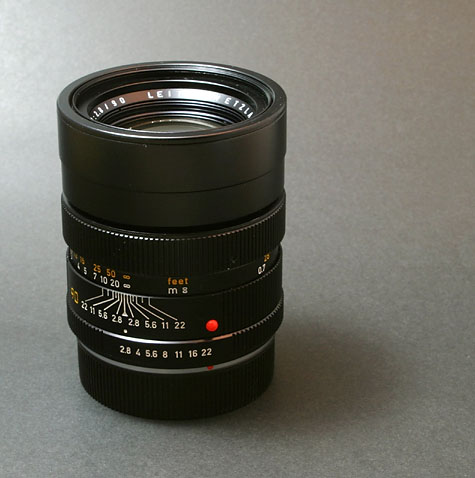 |
4群5枚構成のこのレンズの登場は古く1964年に Leicaflex Mark I と同時に発表された。従って数年の間、つまり Summicron-R 90mm/f2 が登場するまでは、R系の唯一の中望遠であったことになる。開放値を f2.8 に押さえたせいか、ソツのない仕上がりのレンズだと思う。また、Rレンズの欠点(だと筆者は思う。)である重量もまぁ耐えられる重さ(500g)になっている。手に取ってまず感動するのは、そのフードの作りで、仮にカラーの色合いに関して後年の Type II を支持することがあっても鏡筒の作りに関しては圧倒的に Type I のこのレンズの方が優れている。開放から良好なピントを結ぶが絞り込んで使う場合には、やや硬い表現になるようだ。また順光下で撮るとややコントラストがつき過ぎるとも思うが、当時のネガ・フィルムの特性を補うような写りの傾向だったのだろう。この描写の特徴は、Elmarit-R 28mm/f2.8 Type I にも見られ、また Elmarit-R 35mm/f2.8 Type I や Summicron-R 50mm/f2 Type I との併用でもほぼ同じ感覚で使用することが可能である。これは私の持論だが、Rレンズの最も美味しいところはこれら小口径レンズの素晴らしさにあると言う事で、ボケボケの大口径路線に行かずとも充分に堪能できる「良さ」だと思う。
This 5-elements in 4 group Type I lens appeared at the same time of the introduction of Leicaflex back in 1964. Therefore, until the introduction of Summicron-R 90mm/f2, this was the only mid-telephoto lens suitable for Leica R series. With its f2.8 maximum apperture, this lens became a versatile lens including a good travel companion. When have it, the first impression is an elaborately manufactured hood. We even admit the surpassing result from the Type II lens in its color rendering, by this hood one can easily fall in love with it. Crisp image even at full aperture, the image becomes rather too tight when stopping down and becomes too contrasty under the direct sun light. Those tendency seems that one can expect best result with negative film. I believe that the real McCoy amongst R lenses are those f2.8 Elmarits.
|